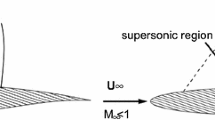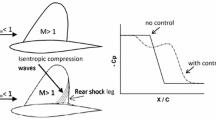Abstract
Both shock control bump (SCB) and suction and blowing are flow control methods used to control the shock wave/boundary layer interaction (SWBLI) in order to reduce the resulting wave drag in transonic flows. A SCB uses a small local surface deformation to reduce the shock-wave strength, while suction decreases the boundary-layer thickness and blowing delays the flow separation. Here a multi-point optimization method under a constant-lift-coefficient constraint is used to find the optimum design of SCB and suction and blowing. These flow control methods are used separately or together on a RAE-2822 supercritical airfoil for a wide range of off-design transonic Mach numbers. The RANS flow equations are solved using Roe’s averages scheme and a gradient-based adjoint algorithm is used to find the optimum location and shape of all devices. It is shown that the simultaneous application of blowing and SCB (hybrid blowing/SCB) improves the average aerodynamic efficiency at off-design conditions by 18.2 % in comparison with the clean airfoil, while this increase is only 16.9 % for the hybrid suction/SCB. We have also studied the SWBLI and how the optimization algorithm makes the flow wave structure and interactions of the shock wave with the boundary layer favorable.
Similar content being viewed by others
Abbreviations
- A T :
-
Jacobian of convective flux
- c :
-
Speed of sound
- C B /l B :
-
Bump degree of symmetry
- Cd p :
-
Pressure drag coefficient
- Cd t :
-
Airfoil drag coefficient
- Cd v :
-
Viscous drag coefficient
- C f :
-
Skin friction coefficient
- Cl :
-
Airfoil lift coefficient
- C p :
-
Pressure coefficientt
- C Q :
-
Non-dimensional mass flow
- ds :
-
Surface element
- E :
-
Total energy per unit mass
- f :
-
Hicks-Henne Sine-function
- F :
-
Cost function
- f inv :
-
Inviscid flux vector
- f vis :
-
Viscous flux vector
- G :
-
Gradient vector of cost function
- H :
-
Total enthalpy
- h B :
-
Maximum bump height
- K :
-
Turbulent kinetic energy
- l B :
-
Bump length
- L/D :
-
Aerodynamic efficiency
- M −T :
-
Transition matrix of non-conservative variables
- \(M_{\infty }\) :
-
Free stream Mach number
- n x ,n y :
-
Component of the unit normal vector
- p :
-
Static pressure
- p t a r :
-
Static pressure target on airfoil surface
- P 0 :
-
Total Pressure
- \(P_{\infty }\) :
-
Free stream pressure
- q k :
-
Heat flux
- r :
-
Penalty function parameter
- Rey \(_{\infty }\) :
-
Free stream Reynolds number
- S :
-
The control volume surface
- S n :
-
Normal distance from the airfoil surface
- S w :
-
The airfoil surface
- t :
-
Bump slope parameter
- T :
-
Static temperature
- \(U_{\infty }\) :
-
Free stream velocity
- U :
-
Vector of flow variable
- u,v :
-
Cartesian velocity component
- V :
-
Contra variant velocity
- x,y :
-
Cartesian coordinate system
- x 0 :
-
Beginning of bump
- Y+ :
-
Non-dimensional wall coordinate
- α :
-
Airfoil angle of attack (AoA), deg
- γ :
-
Ratio of specific heat coefficient
- δ k m :
-
Kronecker symbol
- κ :
-
Thermal diffusivity coefficient
- λ :
-
Second viscosity coefficient
- μ :
-
Dynamic viscosity coefficient
- μ t :
-
Turbulent viscosity coefficient
- τ :
-
Shear stress across the control volume surface
- τ k m :
-
Component of viscous stress tensor
- ρ :
-
Density
- ω :
-
Turbulent specific dissipation rate
- ψ :
-
Vector of adjoint variable
References
Milholen, I.I.W.E., Lewis, L.R.: On the application of contour bumps for transonic drag reduction. In: AIAA 43rd Aerospace Sciences Meeting and Exhibit, AIAA 2005-0462, Reno (2005)
Patzold, M., Lutz, T.H., Kramer, E., Wagner, S.: Numerical optimization of finite shock control bumps. In: AIAA 44th Aerospace Sciences Meeting and Exhibit, pp. 9–12 Reno (2006)
Evans, M.R., Hynes, R.J., Norman, D.C., Thomason, R.E.: Automatic flight control modes for the AFTI/f-111 mission adaptive wing aircraft. AGARD-CP-384. 25 (1984)
Stanewsky, E., Delery, J., Fulker, J., de Matteis, P. (eds.): Drag Reduction by Shock and Boundary Layer Control. Notes on Numerical Fluid Mechanics and Multi Disciplinary Design, vol. 80, pp. 3–4 (2002)
Ashill, P.R., Fulker, J.L., Shires, A.: A novel technique for controlling shock strength of laminar-flow aerofoil sections. In: Proceedings 1st European Forum on Laminar Flow Technology, pp 175–183. Hamburg (1992)
Qin, N., Zhu, Y., Shaw, T.H.: Numerical study of active shock control for transonic aerodynamics. Int. J. Numer. Methods Heat Fluid Flow 14(4) (2004)
Bhattacharjee, S., Ahsan, M., Saha, M., Mohammad, M.: Numerical analysis of shock and boundary layer control over NACA0012 by contour bump, surface cooling and heating. In: Proceedings of the International Conference on Mechanical Engineering, pp. 29- 31 Dhaka (2007)
Lee, D.S., Bugeda G., Periaux, J., Onate, E.: Robust active shock control bump design using hyper parallel MOGA. Int. J. Numer. Methods Heat Fluid Flow 14, 4 (2012)
Yagiz, B., Kandil, O., Pehlivanoglu, Y.V.: Drag minimization using active and passive flow control techniques. International Journal of Aerospace science and Technology 17, 21–31 (2012)
Vadillo, J.L., Agarwal, R.K., Hassan, A.A.: Active control of shock/boundary layer interaction in transonic flow over airfoils AIAA-01-2975 (2001)
Jameson, A., Leoviriyakit, K., Shankaran, S.: Multi-point aero-structural optimization of wings including planform variations. In: 45th Aerospace Sciences Meeting and Exhibit, AIAA-2007-764, Reno (2007)
Mazaheri K., Kiani, K.C., Nejati A., Zeinalpour, M., Taheri, R.: Optimization and analysis of shock wave/boundary layer interaction for drag reduction by shock control bump. Journal of Aerospace Science and Technology 42, 196–208 (2015). doi:10.1016/j.ast.2015.01.007
Mazaheri, K., Nejati, A., Kiani, K.C., Taheri, R.: The application of the gradient-based adjoint multi-point optimization of single and double shock control bumps for transonic airfoils. International Journal on Shock Waves Detonations and Explosions 25(5) (2015). doi:10.1007/s00193-015-0591-2
Blazek, J.: Computational Fluid Dynamics: Principles and Applications, 2nd edn. Elsevier, Amsterdam (2005)
Menter, F.R., Rumsey, C.L.: Assessment of two-equation turbulence models for transonic flows. In: 25th AIAA Fluid Dynamics Conference Colorado (1994)
RAO, S.S.: Engineering Optimization: Theory and Practice, 3rd edn. Wiley, New York (1996)
Ogawa, H., Babinsky, H., Patzold, M., Lutz, T.: Shock-wave/boundary layer interaction control using three-dimensional bumps for transonic wings. AIAA J. 46(6), 1442–1452 (2008)
Colliss, S.P., Babinsky, H., Nubler, K., Lutz, T.: Joint experimental and numerical approach to three dimensional shock control bump research. AIAA Journal 2, 52 (2014)
Bruce, P.J.K., Babinsky, H.: Experimental study into the flow physics of three dimensional shock control bumps. J. Aircr. 49(5), 1222–1233 (2012)
Eastwood, J.P., Jarrett, J.P.: Toward designing with three-dimensional bumps for lift/drag improvement and buffet alleviation. AIAA J. 50(12), 2882–2898 (2012)
Regenscheit, B.: Drag reduction by suction of the boundary layer separated behind shock wave formation and high Mach numbers NACA TM-1168 (1941)
Smith, D.W., Walker, J.: Test of an area suction flap on a NACA64a010 airfoil at high subsonic speeds. NASA TN d 310, Numerical study of active shock control 465 (1960)
Balleur, J.C., Girodroux-Lavigne, P., Gassot, H.: Prediction of transonic airfoil/wing flow with control using time-accurate viscous-inviscid interaction approach. Results of Project EUROSHOCK II Supported by the European Union 1996-1999 3rd Annual Report (1999)
Birkemeyer, J.: Drag minimization on a transonic wing by ventilation and adaptive contour bump. DLR Research Report 1999-28, Ph.D Thesis University Hannover (1999)
Qin, N., Zhu, Y., Ashill, Pr: CFD study of shock control at Cranfield. In: 22nd International Congress of Aeronautical Sciences, Harrogate (2000)
Tian, Y., Liu, P., Feng, P.: Shock control bump parametric research on supercritical airfoil. Science China 54(11), 2935–2944 (2011)
Koenig, B., Paetzold, M., Lutz, T., Kraemer, E.: Shock control bumps on flexible an trimmed transport aircraft in transonic flow. In: New Res. in Num. and Exp. Fluid Mech. VI, Vol. 96, pp. 80–87, Berlin (2007)
Sommerer, A., Lutz, T., Wagner, S.: Numerical optimization of adaptive transonic airfoils with variable camber. In: 22nd Congress of International Council of the Aeronautical Sciences, Paper ICAS 2000-2.11.1, Harrogate (2000)
Anderson, W.K., Venkatakrishnan, V.: Aerodynamic design optimization on unstructured grids with a continuous adjoint formulation. AIAA Paper, 97–0643 (1997)
Mazaheri K., Zeinalpour, M.: Entropy minimization in turbine cascade using continuous adjoint formulation. J. Eng. Optim. (2015). doi:10.1080/0305215X.2014.998663
Ramezani, A., Mazaheri, K.: Multi-grid convergence acceleration for implicit and explicit solution of euler equations on unstructured grids. In: International Journal for Numerical Methods in Fluids, inter science Wiley publication, vol. 62, pp. 994–1012 (2009)
Lien, F.S., Kalitzin, G.: Computations of transonic flow with ν2-f turbulence model. Int. J. Heat Fluid Flow 22, 53–61 (2001)
Holst, T.L.: Viscous transonic airfoil work shop compendium of results. AIAA Paper-1460 Hawaii (1987)
Huff, D.L., Wu, J-C., Sanker, L.N.: Analysis of viscous transonic flow over airfoil sections. NASA Technical Memorandum 88912, AIAA-87-0420
Whitfield, D.L., Thomas, J.L., Jameson, A., Schmidt, M.: Numerical and physical aspects of aerodynamic flows II. ISBN 978-3-662-09016-9 (1984). doi:10.1007/978-3-662-09014-5
Author information
Authors and Affiliations
Corresponding author
Rights and permissions
About this article
Cite this article
Mazaheri, K., Nejati, A. The Multi-point Optimization of Shock Control Bump with Constant-Lift Constraint Enhanced with Suction and Blowing for a Supercritical Airfoil. Flow Turbulence Combust 96, 639–666 (2016). https://doi.org/10.1007/s10494-015-9671-8
Received:
Accepted:
Published:
Issue Date:
DOI: https://doi.org/10.1007/s10494-015-9671-8




